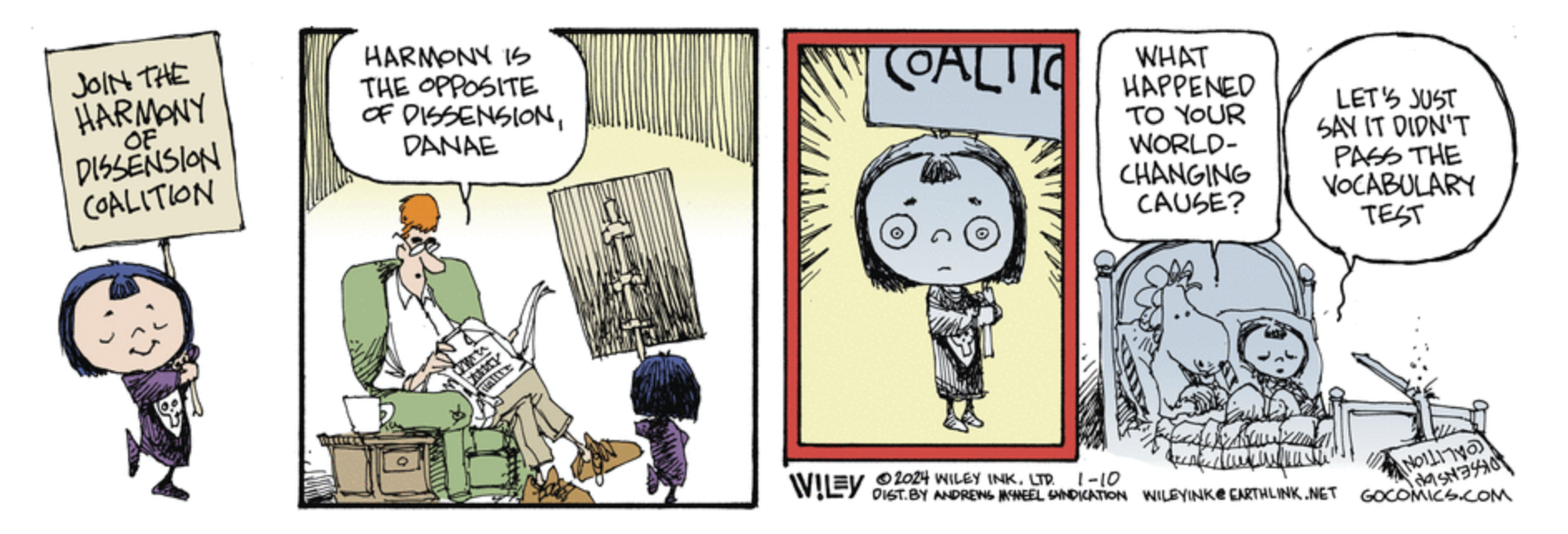The politics of frozen garlic in Taiwan
From Nick Kaldis:
This article begins with a brief reference to the chanting of ‘frozen garlic’ ("凍蒜" dongsuan, Taiwanese pronunciation for "當選" dangxuan "to get elected") in campaign rallies for Taiwan's presidential and legislative elections in two days.
—-
‘Frozen Garlic!’ Taiwan Likes Its Democracy Loud and Proud
At the island’s election rallies, warming up the crowd for candidates is crucial. “You have to light a fire in their hearts,” one host says.
By Chris Buckley and Amy Chang Chien; NYT (1/11/24) Photographs and Video by Lam Yik Fei
Since the NYT is between a high firewall (you can't even see the title of the article), I also provide this link to the whole article at MCLC (Modern Chinese Literature and Culture) Resource Center (The Ohio State University).
Read the rest of this entry »
Foundation misnegation
From Antonio Fortin:
I’m re-reading Asimov's Foundation novels after nearly 35 years and I came across this example in Book 1, which just seems like a mess:
“I don’t say, though,” added Barr, “that there aren’t cases where tech-men haven’t been bribed.”
Obviously, the intended message is that there are cases where tech-men have been bribed, but I’m struggling to arrive at that meaning from the sentence. Shouldn't “haven’t” be “have”? Maybe Language Log readers could help.
Read the rest of this entry »
Don't be afraid of tones
So says Stuart Jay Raj, a Thai-based Australian polyglot who speaks several tonal languages. Here is a half-hour video by him which is linguistics heavy, but is actually an effort to simplify and systematize how tones work. For example, Raj makes a sharp distinction between pitch and tone, something that many people get all mixed up about. Not to mention intonation, which we have often discussed on Language Log.
In this episode, Raj focuses on Burmese, but in other presentations he focuses on different tonal languages and on general principles.
Read the rest of this entry »
Dictionaries are illegal in Florida schools?
Judd Legum, "Florida school district removes dictionaries from libraries, citing law championed by DeSantis", Popular Information 1/10/2024:
The Escambia County School District, located in the Florida panhandle, has removed several dictionaries from its library shelves over concerns that making the dictionaries available to students would violate Florida law. The American Heritage Children's Dictionary, Webster's Dictionary for Students, and Merriam-Webster's Elementary Dictionary are among more than 2800 books that have been pulled from Escambia County school libraries and placed into storage. The Escambia County School District says these texts may violate HB 1069, a bill signed into law by Governor Ron DeSantis (R) in May 2023.
HB 1069 gives residents the right to demand the removal of any library book that "depicts or describes sexual conduct," as defined under Florida law, whether or not the book is pornographic. Rather than considering complaints, the Escambia County School Board adopted an emergency rule last June that required the district's librarians to conduct a review of all library books and remove titles that may violate HB 1069.
Read the rest of this entry »
Fungal language
[Several days ago, I had prepared a post on this topic, but Mark scooped me with his "Mushroom language?" (1/9/24). His coverage of the counterposed Adamatzky and Blatt, et al. papers is superior to mine, so I will just strip out that part of my post and leave the remaining observations with which I had bookended my discussion of the two contesting studies.]
This is a question that I have often pondered myself, viz., how do colonies of more or less loosely associated cells communicate among themselves so that they can become tissues, organs, and so forth:
Under a microscope, the first few hours of every multicellular organism’s life seem incongruously chaotic. After fertilization, a once tranquil single-celled egg divides again and again, quickly becoming a visually tumultuous mosh pit of cells jockeying for position inside the rapidly growing embryo.
Yet, amid this apparent pandemonium, cells begin to self-organize. Soon, spatial patterns emerge, serving as the foundation for the construction of tissues, organs and elaborate anatomical structures from brains to toes and everything in between. For decades, scientists have intensively studied this process, called morphogenesis, but it remains in many ways enigmatic. (source)
Read the rest of this entry »
Mushroom language?
Michael Blatt, Geoffrey Pullum, Andreas Draguhn, Barry Bowman, David Robinson, and Lincoln Taiz , "Does electrical activity in fungi function as a language?", Fungal Ecology 2024:
Abstract: All cells generate electrical energy derived from the movements of ions across membranes. In animal neurons, action potentials play an essential role in the central nervous system. Plants utilize a variety of electrical signals to regulate a wide range of physiological processes, including wound responses, mimosa leaf movements, and cell turgor changes, such as those involved in stomatal movements. Although fungal hyphae exhibit electrical fluctuations, their regulatory role(s), if any, is still unknown. In his paper “Language of fungi derived from their electrical spiking activity”, Andrew Adamatzky, based on a quantitative analysis of voltage fluctuations in fungal mycelia, concludes that the patterns of electrical fluctuations he detects can be grouped into “words” analogous to those found in human languages. He goes on to speculate that this “fungal language” is used “to communicate and process information” between different parts of the mycelium. Here we argue on methodological grounds that the presumption of a fungal language is premature and unsupported by the evidence presented, that the voltage fluctuations he detects are likely to originate as nonbiological noise and experimental artifacts, and that the measured electrical patterns show no similarity to any properties of human language.
Read the rest of this entry »
Tea in Glasgow
Nicholas Tomaino, "The Most Spoken Words in Glasgow", WSJ 1/6/2024:
When someone says, ‘Would anyone like a cup of tea,’ he isn’t offering the best-tasting thing one’s ever had. But that isn’t the point.
The author begins:
I was 23 when I drank my first cup of tea. As an Italian-American, I was raised on coffee. My life changed, however, when I met my wife.
Maddy is a Scot. If you’re from the U.K. or otherwise acquainted with the country, you understand. Tea is imbibed there as if it were water. It features at nearly every meal, and often between them. As William Gladstone wrote, if you’re cold, it’ll warm you; if you’re too heated, it’ll cool you; if you’re excited, it’ll calm you. It can afford to be everywhere, James Boswell noted, because “it comforts and enlivens without the risks attendant on spiritous liquors.”
Read the rest of this entry »
Tone vs. syllable in Cantonese
Andus Wing-Kuen Wong et al., "Tonal and syllabic encoding in overt Cantonese Chinese speech production: An ERP study", PLOS ONE 2023:
Abstract: This study was conducted to investigate how syllables and lexical tones are processed in Cantonese speech production using the picture-word interference task with concurrent recording of event-related brain potentials (ERPs). Cantonese-speaking participants were asked to name aloud individually presented pictures and ignore an accompanying auditory word distractor. The target and distractor either shared the same word-initial syllable with the same tone (Tonal-Syllable related), the same word-initial syllable without the same tone (Atonal-Syllable related), the same tone only (Tone alone related), or were phonologically unrelated. Participants’ naming responses were faster, relative to an unrelated control, when the target and distractor shared the same tonal- or atonal-syllable but null effect was found in the Tone alone related condition. The mean ERP amplitudes (per each 100-ms time window) were subjected to stimulus-locked (i.e., time-locked to stimulus onset) and response-locked (i.e., time-locked to response onset) analyses. Significant differences between related and unrelated ERP waves were similarly observed in both Tonal-Syllable related and Atonal-Syllable related conditions in the time window of 400–500 ms post-stimulus. However, distinct ERP effects were observed in these two phonological conditions within the 500-ms pre-response period. In addition, null effects were found in the Tone alone related condition in both stimulus-locked and response-locked analyses. These results suggest that in Cantonese spoken word production, the atonal syllable of the target is retrieved first and then associated with the target lexical tone, consistent with the view that tone has an important role to play at a late stage of phonological encoding in tonal language production.
Read the rest of this entry »




